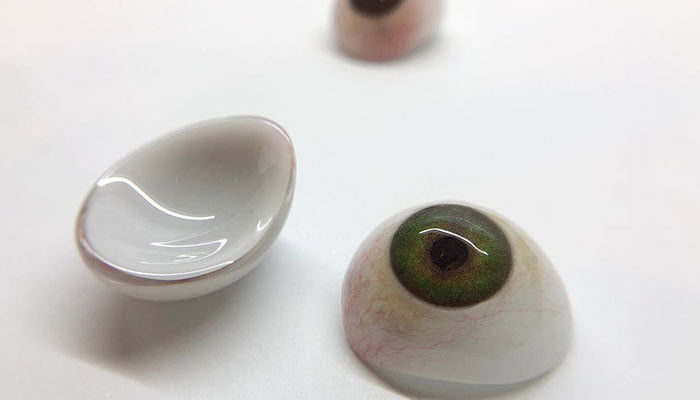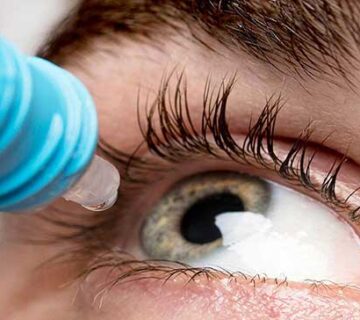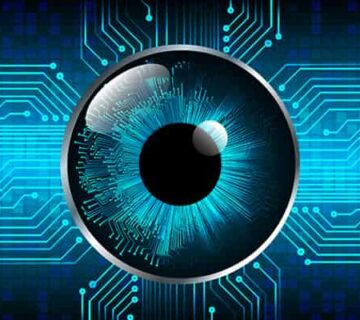Scleral shell or single-layer prosthesis is a type of thin and non-flexible artificial eye (prosthesis). Nowadays, ocular prostheses are used to improve the appearance of damaged eyes. The type of prosthesis used in this area depends on the extent of damage to the person’s eye. One of these examples is the scleral shell or single-layer ocular prosthesis. These prostheses are used in eyes that have lost their beauty due to injury and do not require removal.
Material of Scleral Shell
In the past, the primary material for eye prostheses was glass. However, with technological advancements and to enhance beauty and natural appearance, scleral shells are now made from medical-grade acrylic. This material has no side effects and does not cause any allergies for the user.
Uses of Scleral Shell
This type of prosthesis is usually used in individuals whose eyes have been severely damaged and have lost their aesthetic appearance but do not need eye removal. Typically, the damaged eye in these individuals is smaller than the healthy eye. These patients often also suffer from ptosis, which should be corrected through precise design of the scleral shell.
For individuals who have not had their eyes completely removed and have undergone a partial removal (evisceration), these types of prostheses can also be used. Since this type of prosthesis covers the entire surface of the eye, the appearance of the individual’s eye is greatly improved, making it practically impossible for others to distinguish the artificial eye from the natural one.
The scleral shell prosthesis is essentially an artificial eye without removal, requiring no full eye removal. As the connection of the muscles and eye globe is still intact, the movement of this prosthesis will be similar to that of a natural eye. The artificial eye without removal (scleral shell) is one of those prostheses that closely resembles a natural eye, making it unnoticeable to others when used.
How to Place the Scleral Shell
In most cases, installing the scleral shell in the damaged eye area does not require surgery and can be easily positioned. However, in some cases, the patient’s cornea is sensitive. In such instances, placing the relevant prosthesis in this area can cause symptoms such as pain, severe redness, and continuous tearing. In these conditions, the patient must undergo a surgery called Conjunctival Flap. This procedure prepares the area for the use of the eye prosthesis. It is essential that the necessity of this surgery is confirmed by an ophthalmologist or ocularist. If the scleral shell is compatible with the eye and the aforementioned symptoms do not appear, surgery is not required, and it is better to place the prosthesis without surgery.
What is Conjunctival Flap Surgery and When Is It Performed?
For some individuals, while using the scleral shell, symptoms like pain, redness, and excessive tearing may appear. To alleviate these issues and prepare the relevant area, with the diagnosis of an ophthalmologist or ocularist, these individuals need to undergo Conjunctival Flap surgery.
In this surgery, a very thin layer of the conjunctiva from the damaged eye is pulled over the cornea. This layer acts like a curtain, preventing pain and sensitivity of the cornea.
Scleral Shell Construction and Placement Process
- Molding: Initially, a precise mold of the patient’s eye is taken to ensure the prosthesis fully matches it
- Prosthesis Construction: Based on the mold, the prosthesis is manufactured in the laboratory
- Prosthesis Placement: The prosthesis is placed on the eye outpatiently without the need for anesthesia.
Advantages of Using a Scleral Shell Prosthesis
Using this type of prosthesis has advantages compared to other types, some of which are as follows:
- Since scleral shells do not require eye removal, these prostheses have very desirable movement and move naturally in various directions.
- These prostheses are very light.
- Due to the very low weight of scleral shells, the amount of eye secretions is less than thick prostheses (used in the case of complete removal), making them more comfortable to use.
- Another advantage of these prostheses compared to others is that the patient does not have to endure the side effects of eye removal surgery and its associated costs.
Possible Issues Patients May Face After Using the Scleral Shell
Sometimes, some patients may experience symptoms such as pain and severe tearing in the first few days of using the prosthesis. These symptoms usually disappear after a few days or even hours, as the eye adapts to the prosthesis. If these symptoms worsen, it is necessary for the patient to visit their ocularist and report these issues.
Also, sometimes after using the prosthesis, the damaged eye may become smaller. In this case, there is no need to worry, and the patient may only feel that the prosthesis is small, which can be easily resolved by visiting the ocularist.
Important Tips for Scleral Shell Care
- Regularly wash the prosthesis with the solution prescribed by the doctor.
- Use lukewarm water for washing. Hot water can damage the prosthesis.
- Store the prosthesis in a clean and contamination-free container.
- Never let the prosthesis dry. Always keep it in the solution.
- Avoid hitting the prosthesis, as it may cause damage.
Conclusion
Given the lightness of scleral shells and the absence of the need for complete eye removal, this type of prosthesis has a more natural movement compared to other eye prostheses, making them indistinguishable to others. Additionally, since this type of prosthesis does not require surgery in most cases, it is an excellent option for people with damaged eyes. Therefore, due to the mentioned points, the use of these prostheses is well received among patients.
Mahan prosthetic eye clinic, employing the best specialists in artificial eye manufacturing, is at the service of esteemed patients. Our colleagues at Mahan Clinic are always ready to assist you, and you can contact our experts through the numbers 00982166889076 or 00989128357509. For in-person consultations, you can visit the clinic’s address provided in the contact us section. Moreover, you can view some of the clinic’s work samples by visiting the image gallery section




No comment